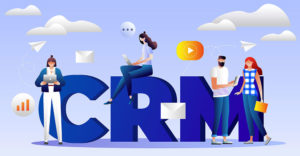Retailers in the U.S. are convinced that customer relationship management (CRM) is one of the most important aspects of their business. However, the sector, in general, has failed to utilize the full potential of these programs, and the industry will be striving to elevate its CRM game in the future. That’s good news not only for customers but also for the providers of CRM technologies and services.
“Although the implementation of CRM is at different levels among individual retailers, I think that as an industry, retailers have seen the effectiveness of using CRM,” Mike Gatti, executive director of the Retail Advertising Marketing Association, told CRM Buyer.
“Those programs not only help retailers understand who their best customers are, they have also helped them focus their spending,” he noted. “You can pinpoint your sales programs better and be more effective in areas like targeted direct marketing,”
RAMA is associated with the National Retail Federation.
In its Retail Horizons 2008-2009 survey of 400 executives at 153 retailers, NRF found that focusing on customer satisfaction and retention was a primary objective. Traditional marketing, based on merchandising and driving traffic through stores through heavy advertising and discounting, may never disappear — but retailers are now paying equal attention to programs that emphasize the individual customer — referred to as “customer-centric.”
“We were impressed that in the survey, customer considerations were the top priority for three straight years from 2007 through 2009,” said Janet Murphy, president of Ogden Associates.
“That was significant during a gloomy period when belt-tightening and other factors were also important,” she told CRM Buyer. Ogden conducted the survey work for NRF.
“Good systems infrastructure and applications are essential both to retailers’ day-to-day survival and to their ability to gain market share in the dog-eat-dog environment that many will face in 2009,” NRF reported.
“While retailers will be watching IT expenditures with particular care in the coming months, they will continue to invest in processes and technology related most closely to their most fundamental business strategies,” the report states. “In this context, the currents of transformation toward a more customer-centered, knowledge-based, and integrated way of doing business will continue to dominate the IT agenda.”
Given the commitment to a customer-oriented future, retailers will need to focus on the programs and e-commerce tools that will best support a viable CRM effort.
Data Management
The foundation for a robust CRM program still requires the generation of data regarding broad consumer trends and, increasingly, more and better information on individual consumers.
“At the end of the day, database technology and data analytics will be the crucial element for the retail sector,” Chris Fletcher, research director at AMR Research, told CRM Buyer.
Traditional retailers that operate through extensive physical stores, as well as online retailers, already gather huge amounts of data about their customers. Past transactions, credit information, and demographic data are relatively easy to compile.
“Retailers have spent big bucks on this, and they have tons of data at their disposal. So far, that has worked in helping them target specific marketing campaigns using special offers and discounts and things like that,” Ogden’s Murphy said.
Currently, retailers may use ZIP code and income level data, say from monitoring home sale prices in a section of the country, for direct mail campaigns to motivate consumers to visit a store. However, such efforts are still a blunt instrument. Enhancing that data with specific customer information is the next challenge. For example, it should be possible at the point of sale (checkout) for a store to generate a coupon related to the amount or type of purchase that could trigger repeat business and create customer loyalty.
Similar customer engagement data can be developed by tracking an individual’s visit to a store Web site, where browsing behavior can be captured. Subsequent visits from the same customer’s computer can trigger special messages or offers related to the browsing history. With the integration of such detailed information from a variety of sources, individual customer needs can be determined, and an array of responses generated to improve the entire customer experience.
Multichannel Contact
Retailers are increasingly using a variety of “channels” to reach consumers, including in-store kiosk displays, e-commerce, call centers, catalog sales, and mobile devices.
“There is good progress in deploying these tools, but right now there is still somewhat of a silo approach, in that retailers haven’t fully integrated all the data they are generating from these channels,” AMR’s Fletcher said. “So it’s hard for them to get a complete view of the customer.”
Retailers plan to aggressively pursue multichannel marketing with increased investments in related technologies. Twenty-one percent of respondents to a survey conducted by AMR Research reported investing between US$5 million and $10 million in cross-channel operations in 2008, and 46 percent planned to upgrade their company’s third generation of cross-channel systems by the end of 2010.
However, only 30 percent of respondents reported having tight integration of their cross-channel and merchandising systems. Investing in integration programs will clearly be a major goal for retailers in the near future.
Social Networking
The development of social networking has not gone unnoticed in the retail sector. With the rise of YouTube, Facebook, and Twitter, another marketing channel has emerged. Both online and brick-and-mortar retailers have adopted social networking mechanisms, such as enabling customers to provide product reviews that can help other customers evaluate those products. However, social networking tools are still at an early stage of development in the sector.
“For most retailers, social networking is an interesting phenomenon to monitor, and they want to be a part of it,” Sallie Burnett, president of Customer Insight Group, told CRM Buyer. “It’s kind of a big black box, and they don’t know quite what their prime objective is for using it.”
A few retailers have quickly seen the potential for social networking, Burnett said, citing Best Buy’s adoption of Twitter for use by store employees and customers.
Brand Identity and Advocacy
Customer loyalty activities have been in place in the U.S. for nearly a century, going as far back as Green Stamps. More recently, the airline model of frequent flyer points has been adopted for retail rewards programs.
All of these require a high degree of e-commerce facilitation tools that fit right into the CRM mold. This trend is increasing, with the added twist of brand advocacy, observed Burnett.
“A satisfied customer can be helpful in passing the word to neighbors whether they are next door or on the Web. The idea is to provide opportunities for customers to actually advocate a product or a retail outlet to their acquaintances,” she said.
The use of social networking tools enhances a consumer’s ability to advocate. While jokes and cartoons are widely recirculated via email, individuals also share a lot of personal financial and business information, Burnett pointed out.
With the retail sector moving to more consumer-oriented marketing, the use of dynamic CRM programs in the sector is likely to continue expanding.
“Retailers today understand the value proposition behind CRM, in that it offers a complete and consolidated view of their customers to truly understand their purchasing behaviors,” Dave Burton, product director for CRM services at Epicor, told CRM Buyer.
With such programs, he said, “retailers can better satisfy the needs and desires of their clientele, gain better insight into which promotional tactics are most successful, encourage improved brand loyalty, and increase wallet share with these customers.”























































John, this is very informative.
There is significant buzz and conversation around the whole social aspect and how it will affect the customer service landscape. Your research confirms a continued interest in this area. Much like all of the other content about this topic, there seems to be no clear cut ROI yet. Unfortunately, I’m not so certain that there will be an easy way to calculate such a number. However, the audience and its involvement in these tools is hard to deny and ignore.
Thanks for sharing the data.